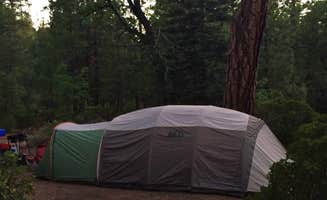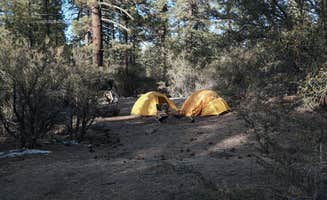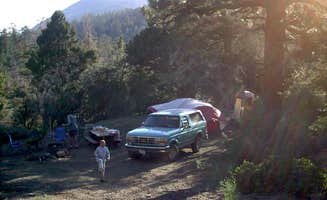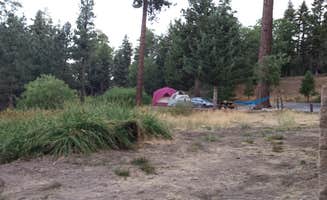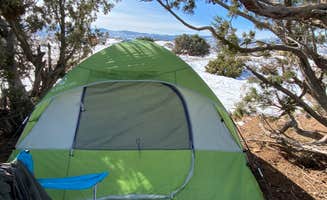San Bernardino National Forest surrounds Big Bear Lake at elevations between 6,700 and 9,000 feet, creating diverse tent camping zones with significant temperature variations. Dispersed camping options extend beyond yellow post sites into areas with primitive conditions requiring campers to pack in all supplies. Weather can change rapidly, with summer days reaching 80°F while nighttime temperatures can drop below 40°F even in July.
What to do
Mountain biking access: Many tent camping areas near Big Bear Lake provide direct access to extensive bike trail networks. At Thomas Hunting Grounds Yellow Post Campites, campers find "excellent place to camp. And free, no less. Need high clearance or 4wd vehicle for a rough road but once you get to the top, the sites are great!"
Rock climbing exploration: The forest surrounding Big Bear Lake features numerous climbing locations easily accessible from tent sites. Holcomb Valley Climbers Camp serves as a hub for this activity, as "this area is used almost exclusively by rock climbers, but anyone is welcomed. As long as you follow the guidelines for the area, you can set up your tent anywhere you see a spot."
Historical exploration: Tent campers can explore remnants of Big Bear's gold rush history while hiking. Near Holcomb Valley Climbers Camp, you'll discover "the site of gold discovery in the 1800s. If you're into panning for gold you just might find some along Holcomb Creek. There are active claims in the area so be respectful."
What campers like
Complete privacy: Tent campers consistently highlight the solitude available at many sites. At Keller Peak Yellow Post Campsites, "there are only 9 sites stretched across 5 miles so you will have no neighbors. Each site is decent size and tucked away into the rocks. Many will fit multiple people easily."
Night sky visibility: The high elevation and minimal light pollution create exceptional stargazing conditions. One camper at Thomas Hunting Grounds noted it was "beautiful, private, and secluded. The campgrounds were wonderful- fair warning only a few campsites have a fire pit. A fire pit is a must in the winter - chilled winds, come prepared."
Forest immersion: Dense pine forest surroundings provide a complete wilderness experience at tent sites. At Tanglewood Group Campground, "campground is nestled in pine woods where you have to drive quite far in through dirt road to get there. Pretty secluded, but accommodate our large group. Spacious for several cars."
What you should know
Access requirements: Many primitive tent camping areas require specific vehicles. At Thomas Hunting Grounds, "make sure you have a vehicle that is 4WD - getting up the mountain is long and rugged."
Wildlife encounters: Tent campers should prepare for wildlife interactions. At Mill Creek Dispersed Camping, "there's no larger wildlife, like bears, so less stressful when you have pets or kids. Plenty of space to bring bikes and ride around."
Wind conditions: High-elevation tent sites often experience significant wind. At Limber Pine Bench Campground, "expect very high winds at night. Setup your camp behind established rock walls and trees and you'll be okay."
Water availability: Nearly all tent sites require bringing your own water. One camper noted, "these sites are basic and no campfires are allowed. You will obviously have no amenities and need to pack in food and water and pack out all trash."
Tips for camping with families
Choose more developed sites: Families often prefer tent sites with basic amenities. At Yucaipa Regional Park, you'll find "great tent camping facilities, privacy from neighbors, access to Zanja Peak Trail head, 3 lakes for fishing, water park during the summer, and friendly helpful staff."
Plan for temperature swings: Prepare children for significant day-to-night temperature changes. One camper experienced extreme cold: "We camped here on our way to summiting San G (as we lovingly call it). Although it was May and the weather was beautiful at sea level, it was cold up here!"
Bring entertainment options: The open spaces at many tent sites provide room for activities. At Yucaipa Regional Park, "there's a lot to do here, including fishing, playgrounds, and even a waterpark in the summer. The bathrooms are decent, no showers."
Tips from RVers
Road condition awareness: Many tent camping areas near Big Bear Lake have challenging access roads. At Mill Creek Dispersed Camping, "the road to the site is gravel, with lots of potholes and washboard areas, which would make it difficult for an RV. But the biggest issue for RVs is an area of the road that is very steep."
Site selection strategy: RVers should carefully research which tent camping areas can accommodate their vehicles. At Big Pine Flat Campground, the campground "is suited more for tenting or overland types" with limited space for larger rigs.
Noise considerations: Some dispersed camping areas experience varied noise levels. At Big Pine Flat, "there is also a OHV staging area directly across from the campsites. The occasional dirt bike is fine right?"


